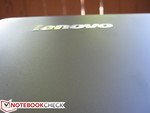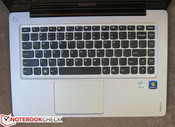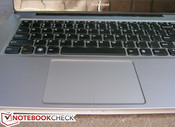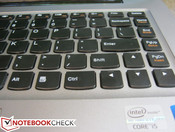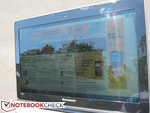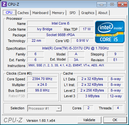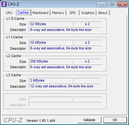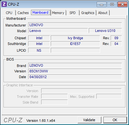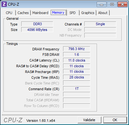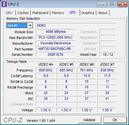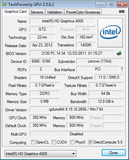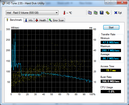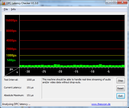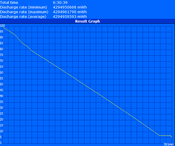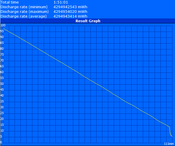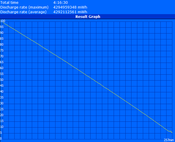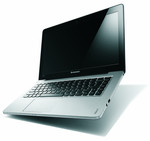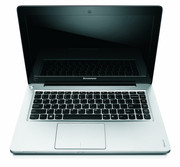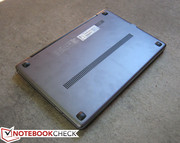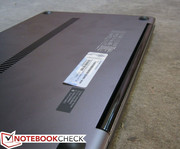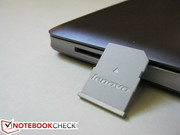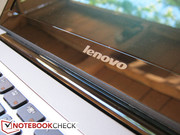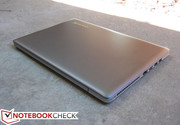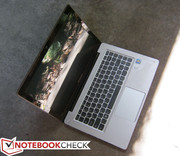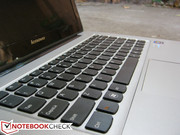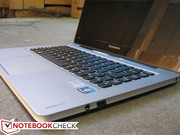Lenovo IdeaPad U310 Laptop Review

Not long after the launch of the IdeaPad U300s late last year, Lenovo announced in January at CES 2012 an expansion to the IdeaPad Ultrabook lineup with the new 13.3-inch IdeaPad U310 and 14-inch IdeaPad U410, complete with Sandy Bridge and Ivy Bridge processors, discrete GeForce 610M options (on the U410), hybrid HDD/SSD storage solutions and Lenovo’s Enhanced Experience 3 (EE 3) system optimizations.
Fast forward six months and Lenovo has only begun shipping both the IdeaPad U310 and U410. As of this writing, Lenovo currently offers just one U310 model through its online store equipped with a Sandy Bridge Core i3 CPU for as low as $599. In this review, however, we will focus on the IdeaPad U310-437526U with its Ivy Bridge ULV dual-core i5-3317U, integrated Intel HD 4000 graphics and a 32GB SSD for system cache. According to Lenovo, such a configuration will be made available starting at $799.
Considering that the first Ultrabooks in 2011 were retailing for as high as $900 to well over $1000 at launch, the comparatively inexpensive IdeaPad Ultrabook series will absolutely catch the eyes of many. In our IdeaPad U400 and U300s reviews, however, we criticized both notebooks for its rather average display performance and a general lack of expandable options. The U310 allows Lenovo to improve upon where the previous models are weakest, but how does this latest addition stack up with its predecessors and the current crop of Ultrabooks?
Case
The IdeaPad U310 continues the attractive-yet-minimalistic aluminum construction and chassis style that it shares with the rest of the IdeaPad Ultrabook lineup. This time around, those who feel deferred by the dull matte gray coloring scheme can opt for livelier blue, pink, or red lid options. But at 0.7 inches (18 mm) thick, the notebook is a tad thicker than the 14.9 mm thick IdeaPad U300s, but still comes in thinner than the 22.6 mm thick IdeaPad U400.
Regardless of the color choice or size, we noticed slight improvements in the stability of the display over the U300s. Wobbling between the front corners of the display is minimal and better than average while the single bar hinge reduces vibrations much more effectively than the similarly-designed hinge of the Toshiba Z830 Ultrabook. The base and palm rest areas are quite the fingerprint magnets, but they are stiff and visibly resistant to finger depressions. With force, side-to-side twisting of the base can be observed, but it is extremely slight and within comfortable levels.
The quality of the construction, while good overall, is not firm everywhere. Typical weak points of a notebook, such as the lid and center of the keyboard, are not as rigid on the the U310 and are actually quite susceptible to flexing from applied pressure. The ostentatious glossy plastic bezel contrasts with the matte aluminum case for better or for worse, and the notebook is also noticeably heavier than the majority of competing Ultrabooks at 3.75 pounds (1.7 kg) compared to the slimmer Asus UX31, Dell XPS 13, Toshiba Z830 and Acer Aspire S3. The additional heft does allow users to open up the display with just one hand, but the smooth round curves and lack of a latch or gap near the front edge does make gripping rather difficult.
Despite the modest drawbacks, it would have been ideal if the U310 provided a much stiffer impression, especially since it is one of the denser and heftier Ultrabooks currently out in the market. Still, the chassis is impressively built for its retail price and leagues beyond many similarly-sized notebooks like the Portege R830 Ultrabook or HP Pavilion dm4-3090se in terms of aesthetics.
Connectivity
The U310 offers most of the expected physical ports for an Ultrabook, including a full-size HDMI port, multiple USB 3.0 ports and even a 10/100 RJ-45 unlike many competing Ultrabooks. Since there are no ports on the rear, the two side and front edges subsequently house all the ports and each one is thus easy-to-reach. The left-hand ports can feel a bit crowded compared to the opposite side, so the notebook is clearly more user-friendly towards right-handed users. This is in stark contrast to the U400, which has most of its ports on the right edge alongside an optical drive.
We can't help but point out that the right edge of the U310 feels rather barren. For example, adding an always-on USB port or a Kensington Lock would have been a definite welcome. The stockier edges could have even allowed for a full-size DisplayPort or VGA-out similar to the Toshiba Z830.
Communication
In terms of wireless connectivity, the U310 includes very little outside of the bare essentials. Wireless-n is provided by the dual-stream (2x2) single-band (2.4GHz) Intel Centrino 2200 with WiDi connectivity. While our review unit lacks Bluetooth, buyers can preconfigure the notebook to include it. Don’t expect any WWAN or GPS functionality – we highly suggest looking into Lenovo’s more business-oriented ThinkPad series (such as the X230) for these kinds of features.
January 14, 2013 update: A handful of U310/U410 owners are reporting significantly reduced wireless speeds, even with a nearby WLAN hotspot. For more up-to-date information, see the official Lenovo forums here.
Accessories
Lenovo has traditionally offered a wide range of first-party accessories for its notebooks and that trend continues here with the U310. However, accessory options here are much more limited compared to the business-oriented ThinkPad series due largely to the lack of a docking port in the more consumer- and multimedia-oriented IdeaPad models. As a result, the U310 currently has no accessories specifically tailored to the notebook and instead relies on USB-powered devices such as keyboards, optical drives, and mice. Larger capacity or secondary batteries are not available as the built-in non-removable 3-cell battery is fixed.
Out of the box, the U310 does come with a handy faux leather black sleeve. It may not be as thick as the ones included with each Asus Zenbook are as classy as the velvet sleeves of the HP Envy notebooks, but the cover is extremely useful nonetheless.
Warranty
The standard one-year base warranty applies here, but users can upgrade to include in-home repair warranty and/or accidental damage protection for up to three years total. Depending on the plan and options, the extended warranty will range anywhere from $30 to $150, which is noticeably less expensive when compared to other manufacturer warranties.
Input Devices
Keyboard
The non-backlit Chiclet keyboard (28cm x 10cm) is identical to the one found on the U.S. models of the IdeaPad U400, U300 or U300s. Each key of the AccuType keyboard is evenly spaced and of generally equal surface area - including the directional keys - unlike most Ultrabooks like the Dell XPS 13, Portege Z835, Acer Aspire S3, Asus Zenbook or the ultrathin Samsung Series 9. As a result, both scrolling and typing on the U310 never become very cramped. The keys are flat with no concavity, but tactile feedback and key depth are both satisfactory and a touch deeper than many Ultrabooks and are even quieter than expected.
However, users may not initially agree with the shorter than usual Shift, Enter, and Backspace keys thanks to the encroaching Home, End, and PgUp/PgDn keys from the right end. Typists who are accustomed to having Enter and Backspace keys on the edge of the keyboard (for example, on MacBooks or desktop keyboards) may require some time to grow accustomed to the smaller sizes and different locations.
The F1-F12 keys take backstage as they can only be activated with an accompanying FN key. Fortunately, users can easily bring these important keys back to the forefront through the system BIOS if desired. Otherwise, we found the keyboard experience of the U310 to be agreeable without any noteworthy issues.
Touchpad
The large and flat touchpad surface is smooth and made of glass, but is still textured similarly to the adjacent palm rests. Its surface area (10.5cm x 7.0cm) is exactly that of the touchpad found on the IdeaPad U300s and similar in size to the touchpads of the XPS 13 or Asus Zenbook UX32. Left and right mouse clicks are integrated into the touchpad, although the bottom half of the surface is more easily clickable than the top half. Despite this, clicking or double-tapping anywhere on the surface will result in a left click input as only the smaller bottom right portion is reserved for right clicks. While the click depth itself is shallow, the feedback feels solid.
Gliding across the touchpad is easy and responsive. Even multi-touch gestures like two-finger scrolling, pinch-to-zoom, and three-finger flicking happen smoothly and quickly without significant misinterpretations or input errors. Up to 5-finger gestures can be recognized by the touchpad, but this is likely a preemptive compatibility feature for Windows 8 as the default Synaptics 8.0 software only provides customization options for up to 4-fingers only.
Lenovo also boasts a “smart sensor” that automatically disables the touchpad while typing to prevent accidental cursor movement. The feature works as intended and proves to be quite useful during word processing.
In general, we found little to complain about the touchpad. Its precise performance makes the notebook that much easier to work with without a nearby mouse. The surface is a huge fingerprint magnet, however, and may be difficult to wipe clean the inevitable grime buildup without a wet cloth.
Display
The display of the U310 offers no surprises. At 13.3-inches with the common 1366x768 pixel resolution, users can generally expect a sharp picture with satisfying colors acceptable for everyday activity. There are no options for higher resolutions, but most 13.3-inch Ultrabooks come standard with the same 720p HD resolution anyway. Notable exceptions include the Asus UX31 and Samsung Series 9 900X3B with their extremely crisp 1600x900 resolution screens, but users will have to cough up a couple hundred more at checkout for these alternatives.
Regardless of cost, we expect every ultraportable display to have sufficiently high maximum brightness and low glare if the notebook is intended for outdoor use. With the Gossen Mavo-Monitor, we measured a low average of about 175 cd/m2 across nine quadrants. The display has one of the lowest maximum brightness we’ve measured in an Ultrabook as all immediate Ultrabook competitors have higher averages ranging from about 200 nits to over 400 nits. Even subjectively the brightness of the U310 is a bit too low -- we always found ourselves turning up the brightness setting close to its maximum for more comfortable indoor viewing.
| |||||||||||||||||||||||||
Brightness Distribution: 88 %
Center on Battery: 187 cd/m²
Contrast: 164:1 (Black: 1.14 cd/m²)
39.96% AdobeRGB 1998 (Argyll 3D)
56.1% sRGB (Argyll 3D)
38.76% Display P3 (Argyll 3D)
The reproducible color spectrum encompasses about 57 percent of the total sRGB spectrum, which is in line with most budget notebook TN displays. Compared to other Ultrabooks, the total gamut volume of the U310 display is actually a bit less, but not by any significant degree. In general, the target buyer will be content with the average contrast ratio and display colors of the U310. Professional graphic artists and others in need of pixel-perfect color accuracy may want to use the U310 more as a secondary notebook rather than a primary workhorse.
Outdoor usability is mediocre. A 200 nit display is the bare minimum that Notebookcheck holds to when determining if a notebook can provide tolerable outdoor performance. Unfortunately, both the low brightness and high glossiness of the display can make outdoor use somewhat of a hassle. Working under shade helps tremendously, but strong reflections may subsequently become a nuisance. Maximum brightness is not reduced when running off batteries, which is definitely a relief as users will need every ounce of backlighting for outdoor viewability.
Viewing angle stability is typical of TN panels. Side-to-side color shifting is minimal, but colors will shift almost immediately if viewing vertically from the top or bottom. Users who need “perfect” viewing angles may want to consider the ThinkPad X220/X230 or even the ultrathin Samsung 900X3B, although the latter option can cost north of a grand.
Performance
The U310 may be similar to its siblings cosmetically, but internally the model can be configured with Intel’s Ivy Bridge class of CPUs. Essentially a 22nm die shrink of Sandy Bridge, the third generation of Core ix processors should theoretically offer the same or better performance than its predecessors while drawing less power. For a full rundown on the architecture, see our in-depth review of dual-core Ivy Bridge CPUs here.
Our review model houses a dual-core 1.7 GHz Core i5-3317U. Although an ULV CPU, it supports Turbo Boost up to 2.4 GHz for both cores and 2.6 GHz for one active core. For more information and benchmarks on the I5-3317U, see our dedicated resource page here.
RAM can be configured up to 4GB through a single module. There are no maintenance hatches whatsoever, so easy configuration or swapping of the hard drive, mSATA drive, battery or RAM is out of the question.
We experienced no recurring high latency peaks with the DPC Latency Checker, even with WLAN active.
Processor
In the synthetic CPU-oriented benchmarks, the i5-3317U is roughly in between the last generation i3-2310M and i5-2410M, both of which are probably the most common mainstream Sandy Bridge notebook CPUs. In terms of neighboring ULV types, the CPU here is roughly on par with the very similar i5-2557M, if not a little faster in raw benchmarks like Super Pi, wPrime and SiSoft. While not a powerhouse, the i5-3317U runs at about half the TDP of those two standard voltage processors above, allowing for markedly improved performance per watt. Users can expect overall CPU performance to lie between notebooks like the ThinkPad Edge E420 and Toshiba Portege R835-P56X.
System Performance
General system performance is typical of a notebook equipped with a 5400RPM drive, although the SSD cache does notably boost final numbers. PCMark 7 and PCMark Vantage returned scores 3491 and 5853, respectively, similar to the SSD-equipped 2011 MacBook Air 13 (i5-2557M) and Samsung Series 9 900X1B (i5-2357M). However, we ran PCMark Vantage for two more full cycles back-to-back in order to see if the SSD cache had any observable effect on the synthetic tests. Our second and third runs both returned distinctly higher overall scores of 8169 and 8733 points, respectively. This puts the U310 ahead of even the MSI GE620 (i7-2630QM/GeForce GT 540M) and Asus N55SF (i7-2630QM/GeForce GT 555M) gaming notebooks equipped with only HDDs, although notebook with pure SSD storage like the SATA III Samsung 900X3B (i5-2467M/HD 3000) still come out much further ahead by about a couple thousand points in the same PCMark Vantage test.
| PCMark Vantage Result | 5853 points | |
| PCMark 7 Score | 3491 points | |
Help | ||
Mass storage
Lenovo has taken the same route as the early Acer Aspire S3 Ultrabooks in terms of storage solution. That is, instead of a full-blown SSD, the manufacturer has opted for a hybrid HDD/SSD setup to save on costs while exploiting the large maximum capacity of mechanical drives.
In the end, the U310 offers a SATA II 5400RPM 320GB or 500GB HDD paired with an optional mSATA 32GB SSD for cache. Our review unit in particular comes equipped with a 500GB Hitachi HTS545050A7E380 and a 32GB Samsung MZMPC032HNCD SSD. With Enhanced Experience 3, RapidBoot and Intel Smart Response Technology (SRT) caching optimizations, a cold boot takes about 20 seconds to reach the desktop. Since the system also uses RAM as a cache for boot files, Lenovo claims that boot times will not increase significantly as more applications are installed overtime.
According to HD Tune, the Hitachi drive offers an average transfer rate of 86.7 MB/s but an unusually high maximum of 280.7 MB/s due to the caching mechanism as data is cached to the SSD during read/write processes for quick retrieval. Funky results also occur in CrystalDiskMark (204.4 MB/s read and 1.040 MB/s write in 4KQD32) for the same reason. The speed advantage of the SSD caching system is definitely tangible to the user especially after repeat usage of the same applications or programs. While a no frills dedicated SSD is still preferable for the best speed, Intel’s SRT combined with Lenovo’s EE 3 work wonders at speeding up the system by means of an otherwise slow 5400RPM HDD.
Out of the 500 GB of space, 44.81 GB is reserved for system recovery and 420.56 GB is immediately available for the end-user. The 32GB SSD cannot be accessed through traditional means as the OS recognizes only one primary physical drive. Under Windows Computer Management, the SSD appears as an 8 GB Hibernation Partition.
For more comprehensive information on various notebook mass storage drives, please refer to our growing HDD/SSD comparison table.
| 3DMark 03 Standard | 8014 points | |
| 3DMark 05 Standard | 5605 points | |
| 3DMark 06 Standard Score | 3332 points | |
| 3DMark Vantage P Result | 1890 points | |
| 3DMark 11 Performance | 438 points | |
Help | ||
GPU Performance
The integrated HD 4000 idles at 350 MHz and can be clocked up to 1050 MHz with Turbo Boost as advertised, which is a bit less than the 1200 MHz maximum of the same GPU found on the standard voltage i5-3210M. However, we’ll gladly take any kind of automatic performance benefit on the ULV processor for better gaming on-the-go.
The 3DMark Vantage score of 1890 points is rather weak and is awfully close to notebooks equipped with a standard voltage Sandy Bridge processor and HD 3000 graphics. For example, the HP Pavilion dm4-3090se (i5-2450M/HD 3000) and ThinkPad X220 (i7-2620M/HD 3000) both scored extremely similarly not just in 3DMark Vantage, but were also able to outscore the U310 in CineBench 10/11 OpenGL tests as well. Many popular modern titles like Bethesda's Skyrim is unfortunately unplayable, but Blizzard games should play relatively smoothly if graphics expectations are kept conservatively low.
| low | med. | high | ultra | |
|---|---|---|---|---|
| StarCraft 2 (2010) | 78 | 18 | 12 | |
| Deus Ex Human Revolution (2011) | 28 | 19 | ||
| CoD: Modern Warfare 3 (2011) | 23 | 14 | 12 | |
| The Elder Scrolls V: Skyrim (2011) | 17 | 12 | 7 |
Emissions
System Noise
Fan noise is minimal, but always audible regardless of the workload. When idle, the constant whirring of the system fan won’t be very perceptible under typical office conditions. Still, we didn’t find the fan bothersome enough to significantly disturb productivity or movie playback or in otherwise quiet settings like libraries or classrooms. 1080p playback through YouTube does increase fan levels slightly up to about 34.2 dB(A), but this is also a nonissue.
When under load, fan noise can increase up to 42.2 dB(A). This is in line with most Ultrabooks if not a little lower as certain models like the Asus UX32 or Dell XPS 13 tend to be a couple decibels or two louder than the U310. The low-pitched whir suggests a larger-sized fan, which would be appropriate here due the thicker chassis compared to other ultrathins. Of course, noise levels this high will never be reached unless gaming or running prolonged CPU-intensive tasks.
Noise level
| Idle |
| 33 / 33.1 / 33.2 dB(A) |
| Load |
| 34.2 / 42.2 dB(A) |
 | ||
30 dB silent 40 dB(A) audible 50 dB(A) loud |
||
min: | ||
Temperature
When left idle, surface temperatures can average well above 30 degrees C on both the base and underside portions. The bottom quadrants closest to the vent are usually the hottest locations, but they are especially warm on the U310 at about 35 to 36 degrees C compared to just 29 degrees C on the opposite end. While not uncomfortable on the lap, users will definitely notice the difference in temperature as these particular spots on the U310 are actually hotter than many other idling notebooks. Fortunately, the temperature range of the top quadrants is more acceptably narrow and should never become a problem during everyday use.
During maximum load, the same quadrants closest to the vent can be as hot as 44 degrees C. The surfaces furthest from the hottest spots increased slightly by only 1 to 3 degrees in comparison. The hot corner will not be comfortable on skin after an extended period of time. Standard web browsing and word processing tasks will never skyrocket the notebook to surface temperatures as recorded here, but we recommend performing any CPU- or GPU-intensive tasks (such as gaming) on a hard surface if possible.
(±) The maximum temperature on the upper side is 43 °C / 109 F, compared to the average of 35.9 °C / 97 F, ranging from 21.4 to 59 °C for the class Subnotebook.
(±) The bottom heats up to a maximum of 44.8 °C / 113 F, compared to the average of 39.3 °C / 103 F
(+) In idle usage, the average temperature for the upper side is 30.4 °C / 87 F, compared to the device average of 30.8 °C / 87 F.
(±) The palmrests and touchpad can get very hot to the touch with a maximum of 36.4 °C / 97.5 F.
(-) The average temperature of the palmrest area of similar devices was 28.2 °C / 82.8 F (-8.2 °C / -14.7 F).
To test for throttling, we utilized both Prime95 and FurMark for stress testing and both HWiNFO and GPU-Z as monitoring tools. First, only Prime95 was initialized to test for CPU throttling. Both CPU cores were able to maintain their advertised 2.4 GHz clock rate at first, but the Turbo Boost enhancement quickly disappeared as both cores dropped to their base 1.7 GHz after only a few minutes. Core temperatures maxed out at 84 degrees C.
When only FurMark was active, the integrated GPU jumped from its base 350 MHz speed and maintained clock rates between 900 MHz and 1050 MHz. Both CPU cores again started out at 2.4 GHz, but steadily dropped to 1.7 GHz over a period of a couple of minutes. According to GPU-Z, the GPU load started at 90-100 percent utilization, but eventually leveled out between 70-80 percent load.
With both FurMark and Prime95 active simultaneously for over an hour, the full stress test did not change core speeds of the GPU or CPU by substantial amounts. The CPU remained at 1.7 GHz while the GPU stabilized at a slight but notably lower 750 MHz to 900 MHz range. Core temperatures, however, were approaching 95 degrees C.
Our standard stress test shows that throttling below the base 1.7 GHz does not occur. In contrast, the Turbo Boost is curiously weak in this Ivy Bridge model... but why?
The <100 percent utilization of the GPU core suggests that the chipset is not receiving the voltage required from the PSU to sustain both the CPU and GPU at maximum loads. However, after some repeat tests, we observed that any benefits from Turbo Boost became automatically nil once both CPU cores hit 84 degrees C. After this threshold was reached, the CPU clock immediately dropped to its base 1.7 GHz and core temperature subsequently fell to a cooler 70 degrees C range. Only when the GPU became stressed did we observe core temperatures crack the 84 degrees ceiling.
We ran 3DMark 06 immediately after we halted the stress test. Since core temperatures are starting out extremely hot (>90 degrees C) this time, Turbo Boost was not expected to be active throughout the test and should subsequently result in a lower CPU score. Our assumption proved correct as the final CPU score came out to be 1731 points, or about 1200 points lower than our initial run.
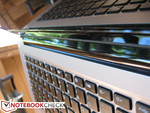
Speakers
The 2x1.5W stereo speakers of the U310 are located behind the chassis underneath the hinge and are actually facing towards the rear (see image). Instead of a straight path, sound waves bounce off of the hinge and lid first before reaching the user.
Sound quality is generally good with a decent range, although the bass is quite lacking. Fortunately, the speakers have avoided the “tinny” quality normally found in small notebooks and ultrathin notebooks. Perhaps more surprisingly, sounds are largely free from any distortions that typically arise when on louder volumes. Thus, users need not worry about plunging sound quality if maximum volume from the speakers are required. Of course, external 3.5mm solutions are still recommended if possible for better extended music or video playback experiences.
Battery Life
Lenovo advertises a battery life of up to 7 hours with the U310. Through the BatteryEater Reader’s Test, we ran our usual maximum battery life test with the lowest possible brightness setting and with WiFi disabled while running under the Power Saver Profile. The system was not allowed to hibernate or sleep. Under these conditions, we clocked in at about 6.5 hours or notably less than the claimed 7 hours. In other words, we were unable to attain the full 7 hours even after leaving the notebook untouched throughout the entire duration.
For minimum battery life, we ran the BatteryEater Classic Test at maximum brightness and WiFi enabled under the Performance Profile. The notebook caved in after about 1 hour and 50 minutes.
Our more reality-oriented WLAN test utilizes the Balance Profile at a screen brightness of about 150 cd/m2 (setting 13/15). We looped our standardized script to simulate typical web surfing conditions with the occasional Flash videos until the battery ran dry. The notebook was able to last about 4 hours and 16 minutes before automatic shutdown.
In terms of total runtime, the U310 could have benefited from a larger capacity battery. The integrated 3-cell 46Wh module offers about the same power as the batteries found in competing Ultrabooks, if not a little lower. Despite this, the Lenovo notebook offers below average runtime, especially under our standard Balance Profile test. For comparison, the Samsung 900X3B (37Wh), Asus UX31 (50Wh), and Dell XPS 13 (47Wh) all have longer battery lives under our same WLAN test at 4hr 56min, 5hr 9min, and 5hr 12min, respectively. We normally wouldn’t mind so much about mediocre battery life if larger capacity options were available, but the 46Wh battery is a fixed option for the U310 regardless of configuration.
Verdict
It’s hard to argue against an Ultrabook starting at just $599 with Ivy Bridge options. Not only does the notebook provide a decently built aluminum chassis, it even looks better than many and has an overall presentation that would suggest a higher price otherwise. When combined with the solid keyboard and the surprisingly large and precise touchpad, the U310 has the first-rate core functionality to justify its impressive looks.
Performance from the hybrid HDD/SSD storage solution with Intel’s SRT is at least noticeable and does its job in the background. We can definitely feel the difference compared to a notebook running on a lone 5400RPM drive, and we’re sure many users will gladly trade a bit of that pure SSD speed for 3x or 4x more storage capacity. System performance is also good with no throttling issues, but the oddly limiting Turbo Boost can be a bit off-putting to some. Even if disregarding the issue, we found no major performance issues elsewhere, such as the decent fan noise and surface temperatures in general.
Of course, corners will have to be cut, some unfortunately more than others. For one, the U310 is a very closed system with no easy access to its motherboard and components like the RAM, HDD and battery. What you see is what you get with the U310, including the somewhat underperforming battery, so the IdeaPad U series probably won’t make it to the top of the list if end-user expandability is of utmost importance.
Secondly, the low screen brightness of the glossy display and the hefty weight of 3.75 pounds are notable hurdles limiting the outdoor potential of the notebook. Most competing Ultrabooks offer slimmer form factors, longer battery lives, brighter screens and sometimes even matte displays for easier use under sunlight or shade. If you’ll want to use this notebook outdoors more than indoors, then there are better Ultrabooks out there for such a purpose.
The IdeaPad was never intended to be a lineup of business notebooks. Hence, the target everyday home user who won’t normally bother with upgrading internal hardware or use the computer outdoors very often may find a lot to like with the IdeaPad U310. The large input devices and conveniently placed ports are both appealing and ergonomic while the shiny screen and bezel will surely catch the attention of many. Add on top an attractive starting price hundreds below that of most Ultrabooks and the IdeaPad U310 will look like a winner to the eyes of the right user.





